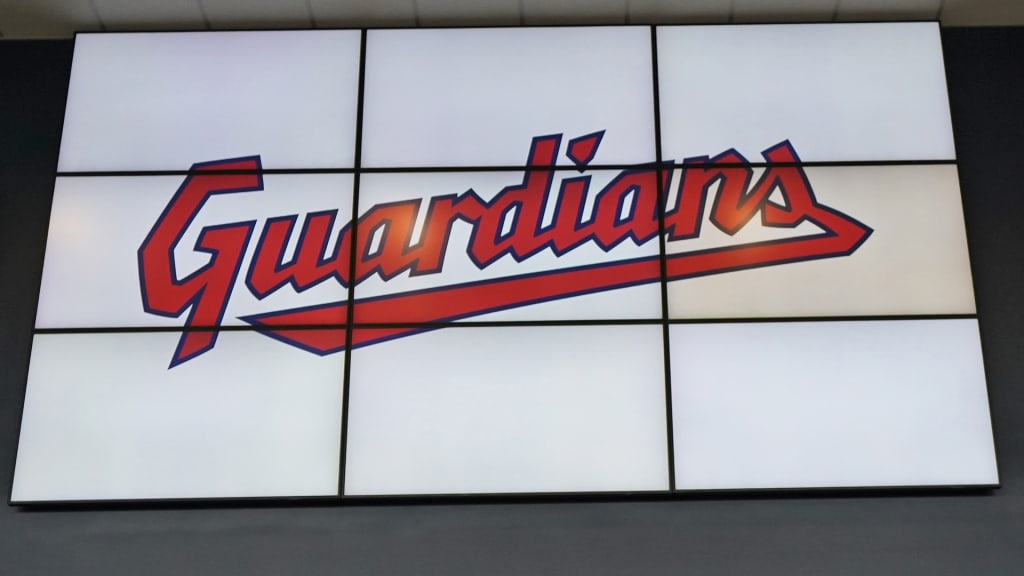
CLEVELAND – The history book about the Cleveland Guardians nickname is just beginning.
On Nov. 19, 2021, the club officially made the switch from the Cleveland Indians to the Cleveland Guardians, representing a new era in Cleveland baseball.
But how did we get here?
When it was clear to the franchise that the former moniker did not please everyone in its community due to its racial connotation, it decided to make a change. From that point on, it decided to lean on local Cleveland fans to help guide the organization on its new path forward.
After 40,000 fans were surveyed and 140 hours of interviews were conducted with those fans, community leaders and front-office personnel, all signs pointed toward the Guardians being the best fit.
Progressive Field looms in the background when facing the 43-foot “Guardians of Traffic” that have stood tall for nearly 100 years on the Hope Memorial Bridge. These sculptures are meant to symbolize progress, a concept that’s now trickling over to the city’s baseball team.
Now, the team is ready to look forward to filling out hundreds of pages of its new history book, but it doesn’t want to erase the century of pages that had already been written.
The Cleveland Indians were in effect from 1915 through the 2021 season.
Baseball teams in Cleveland had a handful of different names, including the Forest Citys, the Spiders, the Bronchos and the Naps, but where did the Indians nickname originate?
There are records of a Cleveland baseball team that date back as far as 1869, referring to the club as the Forest Citys or Blue Stockings. It wasn’t until 1889 that the team became the Spiders -- a name that’s had a resurgence of popularity among the fan base today -- for a 10-year span.
In 1897, the Spiders signed Louis Sockalexis, who became the first Native American in professional baseball. On March 10 of that year, it was written in The Plain Dealer newspaper that Sockalexis was said to be “a fine outfielder and a wonderful batter.” That season, he hit .338 with an .845 OPS in 66 games. But Sockalexis battled alcoholism, and his addiction led to his dismissal from the team in 1899.
When referencing the Spiders, the club is often associated with that disastrous 1899 season, during which the team finished 20-134, according to Baseball-Reference. Owner Frank Robison bought the St. Louis Browns and thought a good team there would draw better, according to Baseball Almanac, and shortly before the start of the season, he transferred all of Cleveland's best players to that team, which he renamed the Perfectos.
In that tough 1899 season, Sockalexis played in only seven games before his dismissal. The Spiders had not always been that bad and had played in the 1895 and 1896 Temple Cups (the precursor to the World Series), winning it in '95. By the end of the year, however, the Spiders were dropped from the National League, and Cleveland was without a baseball team.
Two years later, the current Cleveland franchise was born, but it had yet to determine a regular nickname. The Plain Dealer had referred to the team as the Babes, Spiders, Buckeyes and Clevelands at different points throughout the 1901 season. It wasn’t until 1902 when the Cleveland Press -- the Plain Dealer’s competitor -- named the team the Bronchos.
The Bronchos nickname lasted only one season before the Cleveland Press opened up a fan poll to vote on the Cleveland baseball team’s new moniker. The fans overwhelmingly voted for the Naps in honor of the team’s star player, Nap Lajoie. Buckeyes placed second, Emperors received the third-most votes and names such as the Metropolitans, Giants, Cyclops, Gladiators, Imperials, Armour Clads and Red Devils were also in the running.
Lajoie had a tremendous 13-year career in Cleveland, hitting .339 with an .840 OPS, 919 RBIs and 424 doubles, but when he left for Philadelphia in 1915, the club was left in the predicament of needing to come up with a new name immediately.
While the tale often has been told that because Sockalexis died in 1913, the team was named the Indians in his honor, but that is unlikely. His years with the Spiders coincided with the club’s decline, and his departure from the team was not the most positive. His stardom in Cleveland was not the same as Lajoie’s, which made it less likely that the team would’ve been named after him.
There are old newspaper records that show that the baseball writers were left to vote on a name and had decided on Indians. In 1914, the Boston Braves had won the World Series, which could leave some to wonder if the name for Cleveland -- the last-place team that season -- was inspired by one that experienced great success.
Either way, records have indicated that the Indians name was not intended to be a long-term choice. But after undergoing a handful of different team names over the previous 15 years (and after the team won the World Series in 1920), the moniker ended up sticking for the next 105 years.
Mandy Bell covers the Guardians for MLB.com. Listen to her on the Ballpark Dimensions podcast with Sarah Langs.
